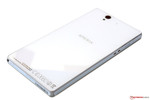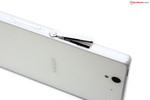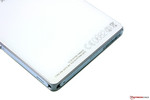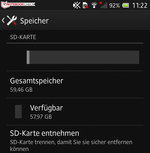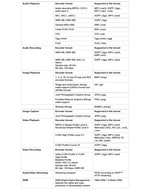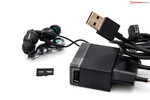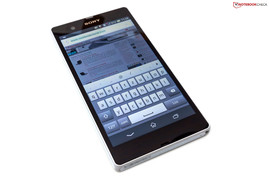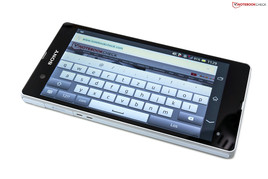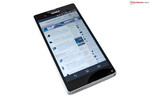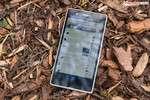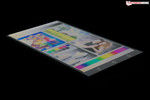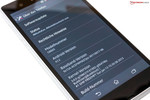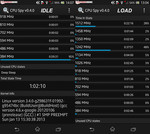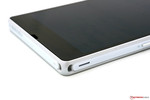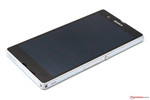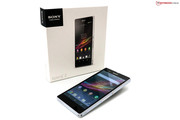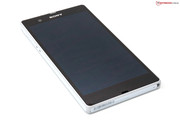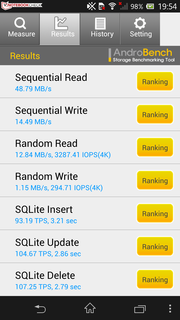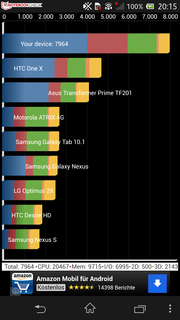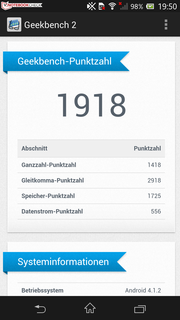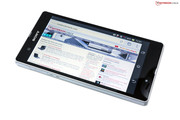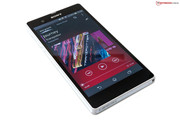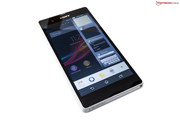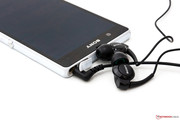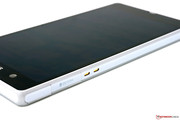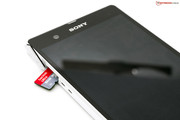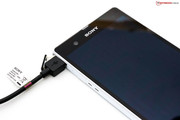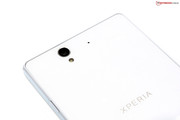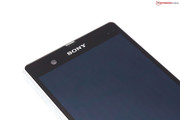Review Sony Xperia Z Smartphone

For the original German review, see here.
The Japanese company Sony introduced the new high-end smartphone Xperia Z during the Consumer Electronics Show 2013 (CES). The new phone - which definitely raises the bar for smartphones - is now available in various countries. The competition doesn't sleep, however: the release of the HTC One (MZ) is right around the corner and we expect Samsung to introduce the Galaxy S4 in New York on March 14th.
What do all those phones have in common? The answer: a high-resolution TFT display with 1920x1080 pixels and 443 ppi. The 5-inch Sony Xperia Z is at the upper end as far as screen size is concerned: larger devices like it are usually called "phablets" - a combination of phone and tablet. Back to our review model: the Xperia Z is powered by a 1.5 GHz Quad-Core SoC (System-on-a-Chip), an integrated Qualcomm Adreno 320 GPU, 2 GB of RAM, and 16 GB flash storage. A card reader for MicroSD cards and LTE wireless complete the package.
Google Android 4.1.2 Jelly Bean is the current version of the mobile operating system. The phone, which is available in black, white, or purple, is available for 649 Euros (MSRP) / ~$845. Is our white review sample all show and no substance?
Case
Unpacking the phone reveals how large, but nonetheless extremely slim it is. Sony uses the term "OmniBalance" to describe this particular design, which is focused on "creating balance and symmetry" and features subtly rounded edges. The white model uses a plastic frame with small inlays. The front and the back are made of tempered glass. The phone ships with barely noticeable protective films applied to the front and back, which should not be removed. Applying a matte screen protector on top of the film doesn't pose any problems.
One distinguishing factor (unique selling proposition or USP) are the IP certifications - worldwide standards, which classify how well a device is protected against solid objects, dust, and water. The Sony Xperia Z complies with IP55 and IP57. The first number (5) indicates the protection against dust, the second indicates how the device handles mild jets (5) and immersion in water (7). Sony states that the Xperia Z can handle submersion for up to 30 minutes without any issues.
The build quality is impressive and the phone appears to be very durable. Even though the surfaces are smooth, they are easy to grip - although gloves or slightly damp fingers should be avoided. When twisting the phone, we didn't notice any creaking sounds, although the display does show some evidence of wave patterns, which also happen when localized pressure is applied to the screen area. The ports are protected with little covers - a feature which accentuates the sleek look of the phone. Because of it, the ports are also protected against dirt, although having to remove the covers can get a little tiresome over time. For those of you who don't like white: Sony also offers the Xperia Z in black and purple for the same price.
Let's look at the dimensions: the smartphone measures 71 x 139 x 7.9 millimeters (5.47 x 2.79 x 0.31 inches) and weighs in at 146 grams / 5.15 oz - fairly large, but not overly so. The Samsung Galaxy S3 measures 71 x 137 x 8.6 millimeters (5.47 x 5.39 x 0.34 inches) and weighs 133 grams / 4.69 ounces. The Google Nexus 4 (139 grams / 4.90 ounces) and the Asus PadFone 2 (135 grams / 4.76 ounces) are also quite comparable. Sony did good work here and managed to put a large display into a fairly compact and lightweight case.
Connectivity
Sony doesn't offer the Xperia Z with different storage capacities - rather, the company chose to supplement the 16 GB of integrated flash storage with a MicroSD card reader supporting up to 64 GB (Sony includes a 2 GB card in the box). The usable capacity of the integrated flash - after the initial configuration - is 11.8 GB (about 74%).
The phone also offers a Micro-USB port which allows video output via MHL (Mobile High-Definition Link). The necessary adapter is not included and needs to be purchased separately. Next to the USB port, we find the card reader and the contact points for the optional docking station. Headsets can be connected using the 3.5 millimeter headphone jack, which is located on the top of the phone. The Xperia Z supports Micro SIM cards; Nano SIMs (Apple iPhone 5) can be used with an adapter.
Software
The Xperia Z ships with Google Android 4.1.2 (Jelly Bean) - the most current version of the Android operating system. Sony didn't modify the standard interface much. We do like the widgets, which can be accessed using the menu of the active applications (right Android button) and positioned freely.
We also like the customized system settings, but wish Sony would have omitted the bloatware - at least said software can be uninstalled easily. The overall performance of the OS is great: apps load quickly and delays are never an issue.
Communication & GPS
The communication options reflect the upscale positioning of the smartphone. Wireless connectivity supports WLAN standards 802.11b/g/n. For connection with (and too) other devices, Bluetooth 4.0 (A2DP) and NFC (Near Field Communication) are available.
Mobile internet access nowadays usually utilizes UMTS/HSPA+ technologies, which allows for speeds of up to 42 Mbit/s. The Xperia Z supports 850, 900, 1900, and 2100 MHz. Of course the smartphone also supports LTE (Long Term Evolution). In Germany, LTE uses 800, 1800, and 2600 MHz. The additional costs for LTE are unfortunately still comparatively high and - at least in Germany - the carriers require a contract.
Applications that require location data can access two different technologies: Assisted-GPS (A-GPS), which uses the American satellite network, and Glonass from the Russian Department of Defense. When we checked the quality of the GPS systems using GPS Test, we had no issues with the performance: the location was acquired within a few seconds and the position established accurately.
Telephony
The phone application is intuitive and neatly arranged. Contacts, favorites, and groups are located next to the dial pad - experienced Android-users as well as complete newbies won't have any problems finding their way around. Since the Xperia Z supports all four major GSM frequencies (850, 900, 1800, & 1900 MHz), the phone can be used in most countries.
Cameras & Multimedia
The Sony Xperia Z offers two cameras. The main camera is on the back, offers 13 megapixels, and can take pictures with 4128x3096 pixels (4:3 aspect ratio) or 1080p (1920x1080 pixels). Photos with a large aspect ratio can be taken at 3920x2204 pixels (9 megapixels). The performance of the camera is OK when compared with the Apple iPhone 5 and our reference camera (Sony NEX-5). The comparison also shows that megapixels aren't everything: the camera of the Apple iPhone 5 produces the same picture quality, even though it features a lower resolution.
The 16x digital zoom should be avoided, since the quality decreases significantly even at the lower end of the digital range. The NEX-5R with its optical zoom clearly shows the difference. HTC seems to be going a different route now: the recently introduced One (codename M7) only features 4 megapixels, although the "Ultra-Pixel" technology is supposed to produce high quality photos despite the lower resolution.
The front camera of the Xperia Z is suitable for video conferencing and simple self portraits. The resolution is 2 megapixels; photos and videos can be recorded at FullHD resolution (1080p - 1920x1080 pixels). The quality compares well to the iPhone 5 - although the pictures are still not very sharp and show visible noise.
The smartphone supports all current audio and video formats. Matroska Media Container (.mkv) is frequently used for high-resolution videos and plays without any stutters or lags. The lossless audio compression format .flac is also supported via the preinstalled Walkman application.
Accessories
The accessories Sony includes don't quite reflect the premium standard of the phone. Aside from the phone itself, the modular USB power adapter, a cable, and documentation, Sony includes a MicroSD card with 2 GB capacity and an in-ear headset. The headset - which is pretty decent quality - and the small SD card are welcome items.
The charging dock DK26, which could be seen during the unboxing of the Japanese version of the Xperia Z, is also included in Germany - our review model shipped without it, however.
Warranty
In some countries, Sony offers a warranty of 24 months. Accessories and the integrated battery are covered for 12 months.
Input Devices & Operation
For text input, the phone offers a virtual keyboard, which pops up automatically. The layout is generous and intuitive. Since there are several Android-specific elements on the bottom of the screen, the keyboard is moved up by a bit when in portrait mode. We like the additional row at the top, which includes many frequently needed special characters and thus makes typing easier.
Users who need to type a lot can do so in landscape mode. The virtual keyboard now starts at the lower border of the screen, although much of the content is not visible any longer. When using Whatsapp and similar applications, it's better to use the phone in portrait mode.
The capacitive touchscreen works very well. Up to 10 fingers can be recognized and multi-touch gestures are executed quickly and accurately. We didn't like the position of the rocker switch for the volume control - it is located too far down, in the same place where we would expect the power button. We would also have liked for Sony to include a dedicated button to open the camera application.
Display
One of the most noticeable features of the Xperia Z is the large "HD Reality Display". The 5-inch panel features a resolution of 1920x1080 pixels (Full HD, 1080p) and offers a pixel density of 443 ppi. The trend right now definitely favors larger displays with higher resolution and corresponding pixel density. The Taiwanese maker HTC has their HTC One, which has a marginally smaller 4.7-inch display. Previous high-end phones can't quite compare: the 4-inch Apple iPhone 5 only has a resolution of 1135x640 pixels (326 ppi) - lower than the 720p standard of 1280x720 pixels. The Google Nexus 4 also only offers 1280x768 pixels and features a 4.7-inch display (320 ppi).
Sony touts their use of the "Mobile Bravia Engine 2" to improve picture quality. This particular technology is supposed to increase the vividness of the TFT panel - something we can confirm: both contrast and color saturation are increased by quite a bit. We did notice one disadvantage: when quickly cycling through high-resolution images, the technology needs up to a second to catch up. Overall, our impression is quite positive: text and pictures are extremely sharp.
We used the Gossen Mavo-Monitor to check the display quality. The brightness is very high: we measured above 400 cd/m² in all areas and an average of 428 cd/m². Sony mentions 500 cd/m² in their specifications, which we could not confirm. The brightness distribution is 88% - good, but not great. The panel is darker on the bottom than on the top, which is fortunately not noticeable.
| |||||||||||||||||||||||||
Brightness Distribution: 88 %
Center on Battery: 441 cd/m²
Contrast: 464:1 (Black: 0.95 cd/m²)
The other measurements are less convincing: the black level value of 0.95 cd/m² is way too high and results in grayish blacks. The contrast ratio of 464:1 is also far from outstanding. Especially for watching movies, we'd appreciate a saturated black and a high contrast ratio.
Outdoors, the phone benefits from the high brightness of the display. Inside, the screen content is easy to decipher, as long as direct light sources are avoided. Direct sunlight or a lamp behind the user require that the brightness is set to maximum - in this case, the low contrast and the glare-type display cause some issues. The content is still easy to identify, even though reflections can't be avoided.
The viewing angles of the IPS LCD panel are also disappointing: even little deviations in the vertical plane cause a loss of brightness. Horizontally, things look better, although we could also observe a decrease in picture quality. We would have expected much better performance in this area.
In addition to the latest version of Google's OS, the Xperia Z also features powerful hardware. The smartphone is powered by the (slightly older) 1.5 GHz Qualcomm Snapdragon S4 Pro APQ8064A SoC, which utilizes four cores, and an integrated Adreno 320 GPU. We already looked at the hardware when we reviewed the Asus PadFone 2. The Mobile World Congress 2013 saw the introduction of a few smartphones featuring the new Snapdragon 600 SoC, which offers more performance, while being more frugal at the same time. The Xperia Z comes with 2 GB RAM and 16 GB integrated flash storage. Sony currently doesn't offer a model with 32 GB or 64 GB - but the card reader allows the user to increase the storage capacity.
We use several different system benchmarks to evaluate the various phones. Our review model achieved 14244 points running AnTuTu Benchmark (Version 3) - a bit lower than older high-end phones, like the Samsung Galaxy S3. The new HTC One X+ with Nvidia Tegra 3 SoC is 14% faster; the much cheaper Google Nexus 4, 23%. However, the Sony does well running NenaMark 2 and GeekBench 2 - the differences are now almost negligible.
Interesting are the results of Basemark ES 2.0: the Sony Xperia Z only manages 38.14 FPS - about half of the Asus PadFone 2, which features the same hardware. The Samsung Galaxy S3 does about as well as the Sony, the HTC One X+ falls behind and ends up in last place in our comparison (15.53 FPS).
For our last benchmark, we ran the Linpack multi-thread test. The Sony Xperia Z scored 570 MFLOPS - a very good result. The Asus PadFone 2 and the Apple iPhone 5 do as well, the Samsung Galaxy S3 ends up with only 137 MFLOPS (-76%).
| AnTuTu v3 - Total Score (sort by value) | |
| Sony Xperia Z | |
| Samsung Galaxy S3 | |
| HTC One X+ | |
| Google Nexus 4 | |
| NenaMark2 - --- (sort by value) | |
| Sony Xperia Z | |
| Samsung Galaxy S3 | |
| Asus Padfone 2 | |
| HTC One X+ | |
| Google Nexus 4 | |
| Geekbench 2 - 32 Bit - Total Score (sort by value) | |
| Sony Xperia Z | |
| Samsung Galaxy S3 | |
| Asus Padfone 2 | |
| HTC One X+ | |
| Google Nexus 4 | |
| Apple iPhone 5 | |
| Basemark ES 2.0 - Taiji Free (sort by value) | |
| Sony Xperia Z | |
| Samsung Galaxy S3 | |
| Asus Padfone 2 | |
| HTC One X+ | |
| Google Nexus 4 | |
| Linpack Android / IOS - Multi Thread (sort by value) | |
| Sony Xperia Z | |
| Samsung Galaxy S3 | |
| Asus Padfone 2 | |
| HTC One X+ | |
| Google Nexus 4 | |
| Apple iPhone 5 | |
Browser benchmark test allow us to compare smartphones with Android OS to phones with Windows Phone 8 (WP8). The Sony Xperia Z uses Google Chrome as the default browser. Running the fairly new Peacekeeper benchmark results in 388 points - faster than the Samsung ATIV S with WP8 (by about 16%), but slower than the Samsung Galaxy S3 (+ 71%), the HTC One X+ (+ 72%) or the iPhone 5. The smartphone from the manufacturer in Cupertino runs the mobile version of the Safari browser and scored 863 points (+ 122%).
The (frequently used) Browsermark 2.0 shows less of a difference: the result of 1773 points places the Sony Xperia Z right in the middle of the current crop of premium smartphones. The Asus PadFone 2 is quite a bit faster though and scores 2592 points (+ 46%). The additional tests Google's V8 and Sunspider 0.9.1 (a JavaScript benchmark) confirm that smartphones with Windows Phone 8 generally score less than phones with Google Android. The Apple iPhone 5 either scores fairly similar or higher than the Android-equipped competition.
| Peacekeeper - --- (sort by value) | |
| Sony Xperia Z | |
| Samsung Galaxy S3 | |
| Google Nexus 4 | |
| Apple iPhone 5 | |
| HTC One X+ | |
| Samsung ATIV S | |
| Browsermark - --- (sort by value) | |
| Sony Xperia Z | |
| Samsung Galaxy S3 | |
| Google Nexus 4 | |
| Apple iPhone 5 | |
| HTC One X+ | |
| Asus Padfone 2 | |
| Nokia Lumia 920 | |
| Samsung ATIV S | |
| Google V8 Ver. 7 - Google V8 Ver. 7 Score (sort by value) | |
| Sony Xperia Z | |
| Samsung Galaxy S3 | |
| Google Nexus 4 | |
| Apple iPhone 5 | |
| HTC One X+ | |
| Asus Padfone 2 | |
| Nokia Lumia 920 | |
| Samsung ATIV S | |
| Sunspider - 0.9.1 Total Score (sort by value) | |
| Sony Xperia Z | |
| Samsung Galaxy S3 | |
| Google Nexus 4 | |
| Apple iPhone 5 | |
| HTC One X+ | |
| Asus Padfone 2 | |
| Nokia Lumia 920 | |
| Samsung ATIV S | |
* ... smaller is better
The integrated flash storage leaves a favorable impression: AndroBench 3 attests a sequential read speed of about 49 MB/s. Only the Google Nexus 4 is a little bit faster here. The Xperia Z does better during sequential writes: up to 14.5 MB/s is possible. The 4KB tests are also convincing. Overall, the performance of the flash module indicates that it is of very high quality.
| AndroBench 3-5 | |
| Random Write 4KB (sort by value) | |
| Sony Xperia Z | |
| Samsung Galaxy S3 | |
| Google Nexus 4 | |
| HTC One X+ | |
| Asus Padfone 2 | |
| Random Read 4KB (sort by value) | |
| Sony Xperia Z | |
| Samsung Galaxy S3 | |
| Google Nexus 4 | |
| HTC One X+ | |
| Asus Padfone 2 | |
| Sequential Write 256KB (sort by value) | |
| Sony Xperia Z | |
| Samsung Galaxy S3 | |
| Google Nexus 4 | |
| HTC One X+ | |
| Asus Padfone 2 | |
| Sequential Read 256KB (sort by value) | |
| Sony Xperia Z | |
| Samsung Galaxy S3 | |
| Google Nexus 4 | |
| HTC One X+ | |
| Asus Padfone 2 | |
Gaming
The integrated Qualcomm Adreno 320 GPU has no issues with gaming - even the more demanding 3D games from Google's Play Store work well. We downloaded ShadowGun: DeadZone and enjoyed the smooth performance on the 5-inch screen. A minor point of criticism: the right side of the screen loses some real estate because of the permanent Android buttons and the menu bar. All things considered though: smartphone-gaming is a lot of fun on this device. The high pixel density of 443 ppi certainly helps here - although the applications need to be optimized for HiDPI displays.
Call quality
We used the Xperia Z for several phone calls and were left with a positive impression: neither we nor our call partners had any issues with the communication quality. The speaker phone - utilizing the mono speaker - also worked well. The sound in general is very natural; ambient noise (train, city, etc.) is filtered well.
Temperature
The Sony Xperia Z runs fairly hot. During idle, the phone gets lukewarm to warm - we recorded up to 36.7 °C (98.06 °F). The back also gets noticeably warm and registers 35 °C (95 °F). A smartphone shouldn't really get warmer than 30 °C (86 °F) in this scenario. Although these measurements are a bit higher than expected, they are still acceptable for daily use.
Under load, temperatures increase as one would expect. After one hour of running a stress test (we use Stability Test), the phone gets quite warm - on the back especially in the upper half. The Asus PadFone 2 does well in this test during idle as well as load scenarios. The Apple iPhone 5 stays cool during idle; under load, it performs about as well as our review model and the Google Nexus 4 or the Samsung Galaxy S3.
(±) The maximum temperature on the upper side is 44 °C / 111 F, compared to the average of 35.2 °C / 95 F, ranging from 21.9 to 247 °C for the class Smartphone.
(±) The bottom heats up to a maximum of 41.9 °C / 107 F, compared to the average of 33.9 °C / 93 F
(±) In idle usage, the average temperature for the upper side is 34.5 °C / 94 F, compared to the device average of 32.9 °C / 91 F.
Speaker
The Sony Xperia Z utilizes a mono speaker located on the right side of the phone towards the bottom. This position is less than ideal, since it's easy to cover the opening with the hand when holding the phone. The sound is surprisingly good - although bass and lows are lacking, both highs and mids are clear. We also did not notice any distortion even with the volume turned up all the way. The HTC One (M7) features two speakers above and below the screen and will probably be the new leader in this area.
A 3.5 millimeter headphone jack allows the connection of headsets or external speakers and offers very good output quality. Another way to hook up external speakers is with a Micro USB to HDMI MHL adapter. The included in-ear headset is also decent, albeit far from qualifying as a high-end accessory. Not everybody will appreciate the form factor, however.
Power Consumption
The power consumption is crucial for a decent battery life. In the case of the Xperia Z, the large display might influence the run times. Our review model consumed between 1.8 and 3.7 watts during idle - higher than average. The Apple iPhone 5 offers superior performance in this area and only consumes 0.4 watts (a difference of 78%). The maximum idle power consumption of the iPhone 5 and the Google Nexus 4 is 1.4 watts (a difference of 62%). The Asus PadFone 2 with the same SoC requires up to 1.9 watts (a difference of 49%).
Under load, the Xperia Z requires up to 6.6 watts. In this case, the difference is much less noticeable: the Google Nexus 4 uses up to 6.5 watts, the Asus PadFone 2 6.1 watts. The clear winners are the Apple iPhone 5 and the Samsung Galaxy S3, which require 2.9 and 3.4 watts respectively. A reason for the somewhat higher power requirements of the Xperia is most likely the larger screen coupled with a high average brightness.
The lithium-ion battery is unfortunately not removable and offers a capacity of 2330 mAh. Since the battery is not replaceable, it's advisable to always pack the included USB cable and charger.
| Off / Standby | |
| Idle | |
| Load |
|
Key:
min: | |
Battery Life
Sony promises a talk time of up to 11 hours and a standby time (WLAN deactivated) of up to 550 hours. Of course, we also run our own tests to determine how the phone performs.
To determine the worst-case scenario, we use the tool Stability Test. For this test, we set the screen brightness to its maximum and enable Wi-Fi. The Sony lasted 2 hours and 23 minutes - not really that bad, considering that the Apple iPhone 5, Google Nexus 4, and the Asus PadFone 2 perform about the same. The Samsung Galaxy S3 pulled ahead and lasted for over four hours. To establish the maximum battery life, we turn the screen brightness all the way down and disable Wi-Fi. In this case, the Xperia Z kept going for 14 hours and 34 minutes before we needed to plug it back in. Google's Nexus 4 did not do as well and managed 12 hours, the Apple iPhone 5 outlasted its competition and kept going for 22 hours.
Our WLAN surf-test simulates a real life scenario. With the screen brightness set to 150 cd/m², a script visits different types of websites in 40 second intervals. Our review model managed 8 hours and 50 minutes before the battery was empty - a result similar to the competition with one notable exception: the Apple iPhone 5 ran for 15 hours and 20 minutes - albeit without any flash videos.
Of course reduced brightness settings are not always an option. We decided to run the aforementioned test with the screen set to maximum brightness: the result is a run time of 5 hours and 20 minutes. We kept the same settings and checked video playback using a Full HD video (1080p, .mkv). The phone shut down after exactly four hours - more than enough for a feature-length movie.
Verdict
The Sony Xperia Z does do many things right: we like the good looking design, the IP certifications, and the extremely sharp 5-inch Full HD display. The phone features many different connection options and its hardware offers good performance. The weakest area of this premium smartphone is its high-resolution display panel: the viewing angle stability is not great, the black level too high, and the contrast way too low. As far as the hardware and performance is concerned, we should take into consideration that the Sony Xperia Z is available now; the HTC One (M7) and Asus PadFone Infinity - both of which will be equipped with the new (and more powerful) Snapdragon 600 SoC - are not released yet.
The camera is good enough for simple snapshots - but in this case, less would have been more: megapixels aren't everything. We like the widgets in the multi-tasking menu of the Google Android 4.1.2 operating system - although they are not really important. The usability of the capacitive touchscreen is good and inputting text is easy. The phone gets a bit too warm during idle, the power consumption is comparatively high, and the battery life is only average. The position of the control elements and the speaker is also less than ideal.
We do know that some users will think that we are too critical - but considering the pretty steep price tag of 650 Euros (~$850), we really would expect a better-performing display. As it stands now, we don't think the Xperia Z is going to have an easy time taking on the competition.




